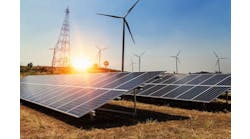Optimal Climate Change Adaptation is Priority Number One
Advisian’s Tristan Jackson and Andrea Ruotolo stress the importance of climate change adaptation in designing a more sustainable, distributed, resilient grid of the future.
Andrea Ruotolo, senior manager, smart & distributed energy, Advisian
As new technologies become available and new conditions emerge, proactive adaptation can cost much less than reacting, particularly when some costs are intangible. When it comes to climate change, we hear a lot about mitigation (addressing the causes of climate change, primarily by reducing greenhouse gas emissions), and less about adaptation (bracing for the impacts of climate change). As important as mitigation is, adaptation should be our primary concern. Mitigation and adaptation are not mutually exclusive; rather, they are a complementary set of actions in an overall strategy. That said, no matter how much we mitigate, in the best-case scenario we still must adapt to unavoidable warming and related impacts of past emissions. Impacts of extreme weather events are not a matter of maybe someday. They are clearly measurable now. The sooner we can adapt our thinking, conversation and efforts to climate change adaptation, the more effective we will be in limiting losses.
Tristan Jackson, director, smart and distributed energy, Advisian
Claims supporting the need to adapt
Leaving the science aside for a moment, one of the best measures of the effects of climate change are insurance claims. If you want to know the cost of risk, ask an insurance company. Last year, Swiss Re Group, one of the world’s leading providers of insurance and reinsurance, reported that, “Total global economic losses from natural disasters and manmade catastrophes were USD 337 billion in 2017.” Compared to the previous year, this is an increase in total economic losses of 87%, and an increase in insured losses of 158%. Unfortunately, the overall trend shows that 2017 was not a one-year anomaly. So far this century, every year has seen at least one new record-setting weather event.
According to Don Forgeron, president and CEO of the Insurance Bureau of Canada, “There’s no question that we’ve entered an era of increased threat to life and property. From 1983 to 2008…insured losses in Canada averaged about $400 million. Over the last decade, that number jumped up to about $1 billion per year, and it was closer to $2 billion in 2018… so, we’re seeing more severe weather events, more damage, more insurance claims, greater strain on the government treasury, and increased heartache and anxiety for countless Canadians…”
Re-engineering engineering
Extreme weather is just one of the reasons insurance claims are trending up. Compared to 50 years ago, there is not only more infrastructure in place for storms to hit, but it is in more precarious condition. Of all the systems we rely on, none is more central to our lives and more in need of a massive upgrade than our electricity grid. The United States, alone, needs to spend an estimated $2.1 trillion over the next 30 years to modernize the electricity grid, according to a report from the International Energy Agency. Meanwhile, more of our economic activity and our safety systems depend on reliable electricity more than ever before. These challenges intersect: Extreme weather events are increasing in force and frequency, more people are in positions of risk and power grids require continuous improvements, upgrades and hardening. A recent example of this intersection is the California utility PG&E filing for bankruptcy due to liability of over $30B in damages, for its role in starting California’s most destructive wildfires in history in 2017 and 2018. This is one illustration of how the impacts of climate change (hot, dry summers) and the condition of the grid (sparks flying) can affect companies and taxpayers right now.
Eight of the 10 largest blackouts in U.S. history happened in the past 20 years, with three of the largest four in the past decade. (Graph: DOE)
Eight of the 10 largest blackouts in U.S. history happened in the past 20 years, with three of the largest four in the past decade.
With more destructive weather, an aging grid, and more lives and business activity in the balance, it is time for us (the power industry, and engineers) to disrupt ourselves. We cannot build more of the same. We cannot approach how we do our jobs in the same way we have for decades.
The rise of the optimal
In terms of our energy system, as we adapt, it is essential that we also create value. Two such ways to maximize value creation is to streamline the process, reducing time to results; and, to design optimized onsite energy systems that are precisely fit-to-purpose and not wholly reliant on the grid. The way to accomplish both at once is with advanced software that assesses hundreds of thousands of potential solutions and designs optimal outcomes with greater transparency, accuracy, and surety. Such software tools are emerging now and will come to dominate, whether we embrace or resist them. The sooner we embrace, the better. We can either disrupt ourselves or be disrupted by the rise of the optimal.
‘I want to overspend’ – said no one…ever
The majority have caught on by now that the future of energy is more distributed, more renewable and more resilient. Even so, we still often hear, “Sure, but what would that cost? What is the value of resiliency?” The first thing advanced software tools enable us to do is answer that question more affordably and quickly, in hours to days, instead of the industry standard of several months and tens to hundreds of thousands of dollars, via the old-fashioned feasibility study. Advanced design tools are removing process inefficiency.
The next thing they do is correctly size and configure the optimal onsite energy system for any load profile. Optimizing the system ensures we design least cost, best fit solutions for the end user’s unique need. At the same time, we can save them significant capital cost and operating expense throughout the life of the system, taking into account the cost of not having reliable, safe, and low-emission energy. Not surprisingly, these improvements in process and outcomes are things the market demands. We need to leverage the latest software tools available, disrupt our old models, and integrate flexibility in designing the more sustainable, distributed, resilient grid of the future. It’s time to adapt.
Tristan Jackson is director, smart and distributed energy and Andrea Ruotolo senior manager, smart and distributed energy at Advisian.







